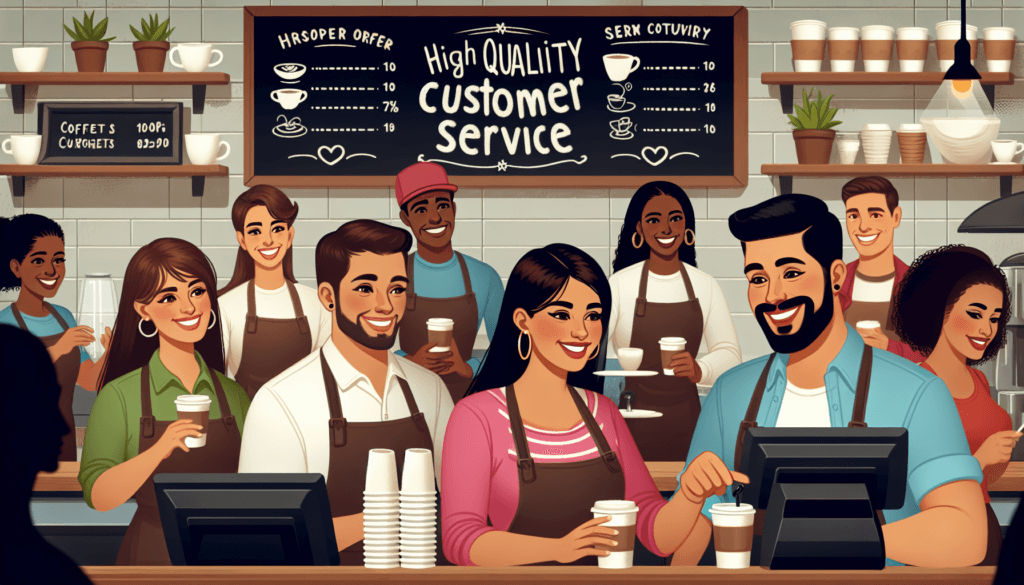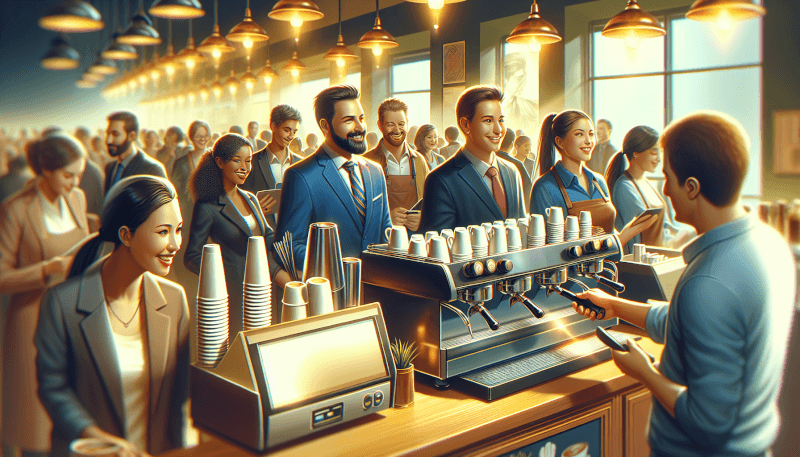When stepping into a coffee shop, you expect more than just a freshly brewed cup of joe. It’s the experience that truly matters, and exceptional customer service can make all the difference. In this article, we’ll explore the best practices for delivering top-notch customer service in a coffee shop. From creating a welcoming atmosphere to anticipating customer needs, these strategies will help you provide a delightful experience that keeps customers coming back for more. So grab a cup of coffee, and let’s dive into the world of exceptional customer service in a coffee shop.

Creating a Welcoming Environment
Clean and organized space
One of the key factors in creating a welcoming environment in a coffee shop is ensuring that the space is clean and organized. A clean and tidy space not only gives a positive first impression to customers but also contributes to their overall experience. Regular cleaning and maintenance should be prioritized to ensure that tables, chairs, and floors are always free from dust, debris, and spills. Additionally, keeping counters, display cases, and condiment stations well-organized helps customers navigate the space easily and find what they need without any hassle.
Comfortable seating
Another important aspect of creating a welcoming environment is providing comfortable seating options for customers. Investing in quality chairs and sofas that are designed for long periods of sitting can greatly enhance the customer’s experience. It’s important to consider the ergonomics and support provided by the seating options to ensure that customers can relax and enjoy their time in the coffee shop. Whether it’s offering plush chairs, cozy booths, or outdoor seating, providing a variety of comfortable seating options will cater to the diverse preferences of customers and make them feel valued.
Relaxing ambiance
The ambiance of a coffee shop plays a significant role in creating a welcoming environment. Soft lighting, soothing music, and warm colors can create a relaxing and cozy atmosphere that encourages customers to unwind and enjoy their coffee. The use of decorative elements such as plants, artwork, or bookshelves can also contribute to a welcoming and homely atmosphere. It’s important to strike a balance between creating a lively and bustling environment and maintaining a sense of tranquility where customers can have a peaceful experience. A well-curated ambiance can leave a lasting impression on customers and make them want to return to the coffee shop time and time again.
Training and Development
Customer service training
Investing in customer service training is essential for providing exceptional service in a coffee shop. It’s important for staff to understand the value of customer satisfaction and the impact their interactions can have on the overall customer experience. Customer service training should cover topics such as effective communication, handling difficult customers, and problem-solving. Role-playing scenarios can also be beneficial in training staff to handle various customer service situations. By empowering your staff with the skills and knowledge necessary to provide top-notch service, you can create a positive and memorable experience for your customers.
Product knowledge
Having a well-trained staff that possesses extensive product knowledge is crucial in a coffee shop. Employees should be familiar with the different types of coffee beans, brewing methods, and specialty beverages offered. This knowledge enables them to answer customer questions, make recommendations, and guide customers in their coffee choices. Training sessions focused on product knowledge can help staff develop a comprehensive understanding of the coffee shop’s offerings, allowing them to enhance the customer experience through informative and personalized interactions.
Barista skills
Baristas are the heart and soul of a coffee shop, and their skills play a significant role in the customer’s experience. Proper training in the art of coffee preparation and latte art can elevate the quality of drinks and add a touch of creativity. Baristas should be trained to consistently produce well-executed espresso shots, frothed milk, and beautifully presented beverages. Additionally, training baristas in time management and multitasking can ensure that orders are prepared efficiently and customers are served promptly. Investing in barista training not only improves the overall quality of the coffee shop’s offerings but also enhances the customer’s enjoyment and satisfaction.

Efficient Order Taking
Clear and concise communication
Efficient order taking starts with clear and concise communication between the customer and the staff. It is important for staff members to speak clearly, enunciate their words, and use simple and easy-to-understand language. This helps to minimize any potential misunderstandings and ensures that the order is accurately taken. Additionally, staff should be proactive in asking clarifying questions if they are unsure about the customer’s preferences or order specifications. Clear and concise communication sets the foundation for a smooth ordering process and enhances the customer’s experience.
Active listening
Active listening is a crucial skill for staff members when taking orders. It involves fully focusing on the customer, maintaining eye contact, and giving them undivided attention. By actively listening to the customer’s preferences, staff can accurately capture their order details and make any necessary adjustments. This not only prevents errors in the order but also demonstrates to the customer that their needs are valued. Active listening creates a positive interaction and enhances the overall customer experience.
Taking accurate orders
Accuracy is key when taking orders in a coffee shop. Staff should ensure that they write down or enter the order details correctly to avoid any misunderstandings or mistakes. Double-checking the order before confirming it with the customer is an important step to ensure accuracy. It is also beneficial to repeat the order back to the customer to confirm that it has been correctly understood. Taking accurate orders not only prevents frustrations or disappointments for the customer but also showcases the coffee shop’s commitment to delivering high-quality service.
Speed and Efficiency
Streamlined processes
Efficiency in a coffee shop relies on having streamlined processes in place. From the moment a customer enters the shop to the moment they receive their order, every step should be designed to minimize wait times and maximize productivity. This can include well-designed layouts that facilitate easy movement for both customers and staff, strategically placed equipment and supplies, and clear signage or digital displays that guide customers through the ordering process. Streamlined processes ensure that customers are served promptly and reduce any potential bottlenecks, resulting in a smooth and efficient experience.
Effective workflow
An effective workflow is essential to maintain speed and efficiency in a coffee shop. Staff should be organized and have clear roles and responsibilities assigned to them. This ensures that tasks are completed in a timely manner, orders are prepared efficiently, and customers are served promptly. Efficient workflow also involves effective communication and coordination among staff members, allowing them to seamlessly assist each other as needed. When customers observe the smooth and organized flow of operations, they are more likely to have a positive perception of the coffee shop and its service.
Quick service
Providing quick service is a fundamental aspect of customer satisfaction in a coffee shop. Customers often visit coffee shops when they are on the go and have limited time to spare. Staff should strive to serve customers promptly, without compromising on quality. This can be achieved by minimizing wait times at the ordering counter, optimizing the coffee brewing process, and properly managing the queue. Efficient time management and attention to detail contribute to quick service, allowing customers to enjoy their coffee without unnecessary delays and creating a positive experience.

Quality Products
Freshly brewed coffee
Offering freshly brewed coffee is a cornerstone of maintaining quality in a coffee shop. Coffee beans should be sourced from reputable suppliers and roasted to perfection. Regularly grinding the beans in small batches ensures that the coffee is fresh and aromatic. Staff should be knowledgeable about brewing techniques and should follow best practices to achieve consistent flavor and quality. By prioritizing the freshness of the coffee and delivering a rich and flavorful cup every time, a coffee shop can establish a reputation for offering high-quality products.
High-quality ingredients
In addition to fresh coffee, using high-quality ingredients in specialty beverages and food offerings is crucial for maintaining customer satisfaction. From syrups and sauces to milk and toppings, all ingredients should meet the coffee shop’s quality standards. By using premium ingredients, the coffee shop can ensure that the taste and presentation of their products exceed customer expectations. Staff should be trained to handle ingredients with care and follow standardized recipes to consistently deliver a delightful experience.
Consistent taste
Consistency is key when it comes to the taste of coffee and other beverages in a coffee shop. Customers often develop preferences for specific flavors or blends and expect them to be consistently replicated in each visit. Staff should be trained to follow standardized recipes, measure ingredients accurately, and maintain consistency in brewing techniques. Regular quality checks and taste testing can also help ensure that the flavor profiles of the coffee shop’s offerings remain consistent over time. Consistent taste builds credibility and trust with customers, encouraging them to become regular patrons of the coffee shop.
Personalized Service
Remembering customer preferences
Providing personalized service involves going the extra mile to remember and anticipate customer preferences. Staff should make a genuine effort to remember regular customers and their favorite orders. This can be as simple as addressing the customer by their name or remembering their preferred coffee customization options. Recognizing regular customers creates a sense of familiarity and makes customers feel valued, fostering a strong sense of loyalty to the coffee shop.
Using customer names
Addressing customers by their names adds a personal touch to the service experience. When staff members use customer names during interactions, it establishes a friendly and welcoming environment. This practice demonstrates attentiveness and creates a more personalized experience. Encouraging staff members to learn and use customer names is a small yet effective way to make customers feel appreciated and create lasting connections.
Engaging in conversation
Engaging in conversation with customers is an excellent way to foster a warm and friendly atmosphere in a coffee shop. Staff can initiate conversations by asking about the customer’s day or discussing topics related to coffee, such as new blends or brewing techniques. This creates a sense of community and encourages customers to feel comfortable and welcome. Genuine engagement and attentive listening help build relationships with customers, making their visit more enjoyable and memorable.

Resolving Complaints
Active problem-solving
Resolving complaints effectively requires a proactive approach to problem-solving. When a customer approaches staff with a complaint, it is essential to actively listen to their concerns, demonstrate empathy, and take ownership of finding a solution. Staff should ask open-ended questions to fully understand the issue and work collaboratively with the customer to address their concerns. By actively seeking resolutions and taking prompt action, staff can turn a negative experience into a positive one, leaving the customer satisfied and likely to return.
Empathy and understanding
Empathy and understanding are vital when dealing with customer complaints. Staff should empathize with the customer’s perspective and validate their feelings of dissatisfaction. Demonstrating empathy helps to de-escalate tensions and creates a supportive environment for conflict resolution. Understanding the customer’s perspective allows staff to approach the problem with a solution-oriented mindset, prioritizing customer satisfaction and working towards a positive outcome.
Apologizing and taking responsibility
When resolving complaints, it is important for staff to apologize to the customer and take responsibility for the situation. A sincere and genuine apology shows that the coffee shop acknowledges any mistakes or shortcomings and is committed to making it right. Taking responsibility involves admitting to any errors or misunderstandings, assuring the customer that their concerns will be addressed, and taking immediate action to rectify the situation. Apologizing and taking responsibility demonstrates accountability and professionalism, which can help rebuild trust and maintain a positive reputation.
Upselling and Cross-Selling
Product knowledge and recommendations
Upselling and cross-selling can be an effective way to increase sales while providing customers with additional choices. Staff training should include product knowledge sessions, which equip employees with the ability to recommend complementary items or upgrades based on the customer’s preferences. By understanding the coffee shop’s offerings in-depth, staff members can confidently suggest items that complement the customer’s order, enhancing their overall experience and potentially increasing sales.
Incentives and promotions
Incentives and promotions can encourage customers to explore additional offerings and make additional purchases. Offering discounts or special offers on specific menu items can create intrigue and incentivize customers to try something new. Staff should be trained to highlight these incentives and promotions to customers, creating awareness and encouraging them to take advantage of the offers. By incorporating incentives and promotions into the upselling and cross-selling process, a coffee shop can enhance customer satisfaction while boosting its revenue.
Suggestive selling techniques
Suggestive selling techniques involve suggesting or recommending additional items that complement the customer’s order. This can be done by mentioning popular pairings or making personalized recommendations based on the customer’s preferences. Staff should be trained in suggestive selling techniques to ensure that their suggestions are natural, non-pushy, and aligned with the customer’s needs. By effectively employing suggestive selling techniques, staff members can enhance the customer’s experience by offering them options they may not have considered, ultimately increasing the coffee shop’s sales.

Effective Communication
Clear signage and menu boards
Clear signage and well-designed menu boards are essential for effective communication in a coffee shop. Signs should be easy to read, with clear fonts and contrasting colors. The menu boards should be visually appealing and well-organized, displaying the coffee shop’s offerings in a way that is easy for customers to navigate and understand. Clear signage and menu boards allow customers to quickly identify and select their desired items, reducing confusion and improving the overall ordering experience.
Friendly and approachable staff
The demeanor and attitude of the staff play a significant role in effective communication. Staff members should always maintain a friendly and approachable demeanor, welcoming customers with a warm smile and engaging them in conversation. Approachable staff create an inviting and comfortable environment, where customers feel comfortable asking questions or seeking recommendations. By fostering a positive and open atmosphere, a coffee shop can facilitate effective and enjoyable communication with its customers.
Open and honest communication
Open and honest communication is essential for resolving customer queries or concerns. Staff should be honest when answering questions or addressing any issues raised by customers. If a mistake has been made, staff members should be transparent about the situation, apologize if necessary, and provide appropriate solutions. Open and honest communication builds trust and credibility with customers, leaving them more satisfied with their overall experience in the coffee shop.
Customer Feedback
Soliciting customer feedback
Actively seeking customer feedback is essential for understanding and addressing areas of improvement. A coffee shop can solicit feedback through various channels, such as comment cards, online surveys, or social media platforms. Staff should be trained to proactively ask customers for their feedback and explain how their opinions can contribute to enhancing the coffee shop’s services. Creating a welcoming environment where customers feel comfortable sharing their thoughts fosters a culture of continuous improvement.
Feedback management process
Once customer feedback is received, it is crucial to have a proper feedback management process in place. Staff members responsible for managing feedback should compile and analyze the received feedback, categorizing it based on themes or recurring issues. They should promptly address any urgent concerns and develop action plans for addressing broader areas of improvement. Regular meetings or discussions with staff can provide valuable insights into the feedback received, allowing the coffee shop to make informed decisions for improvement.
Continuous improvement
Customer feedback should be viewed as an opportunity for continuous improvement. Through the implementation of feedback-driven changes, a coffee shop can enhance its services and offerings over time. Staff members should be encouraged to actively participate in the improvement process by sharing customer feedback and providing suggestions for betterment. By fostering a culture of continuous improvement, a coffee shop can stay responsive to customer needs and maintain a high standard of customer service.
In conclusion, creating a welcoming environment, prioritizing training and development, ensuring efficient order taking and service, focusing on speed and efficiency, delivering quality products, providing personalized service, resolving complaints effectively, implementing upselling and cross-selling strategies, fostering effective communication, and valuing customer feedback are all crucial best practices for customer service in a coffee shop. By consistently implementing and optimizing these practices, coffee shops can create exceptional experiences for their customers and build a loyal customer base.


